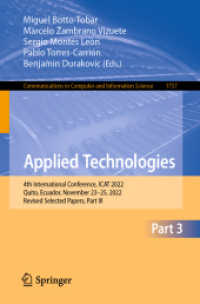- ホーム
- > 洋書
- > 英文書
- > Religion / Ethics
Full Description
A crucial intervention at the intersection of ecotheology and trauma theology
We are in the midst of a global ecological crisis. At times, the scale of the suffering involved can be hard to fully comprehend. The whole planetary ecosystem feels out of kilter. Meanwhile, trauma theorists, and society at large, have become increasingly aware of the incidence of trauma in a growing variety of contexts. In Witnessing a Wounded World Tim Middleton asks what might be gained by viewing ecological suffering through the lens of trauma.
By bringing concepts and methodologies from trauma theology to bear on questions that arise within ecotheology, Middleton engages a series of pressing questions. What kind of traumas are being precipitated by anthropogenic climate change and accelerating biodiversity loss? What would it mean to envisage the Earth itself as traumatized? And how might a Christian theologian respond?
From large-scale deforestation and opencast mining to rampaging wildfires and fracturing ice sheets, the Earth itself is subject to intense devastation. Witnessing a Wounded World analyses such phenomena in terms of three traumatic ruptures—to communication, to flesh, and to time. Drawing on practices of witnessing and the insights of deep incarnation Christologies, Middleton proceeds to offer a theological account of this ecological trauma. For Christians, a model of Christic witnessing can bring the Earth's suffering to light.
As the first sustained treatment of ecological trauma to address the trauma of the Earth itself, Witnessing a Wounded World makes a profound contribution to discussions of suffering, faith, and the present ecological emergency.
Contents
Preface ix
Introduction 1
1 The Traumatized Earth 19
2 Trauma in Ecotheology 41
3 Ecology in Trauma Theology 59
4 The Rupture of Communication: Christ's Witness to a Wounded World 74
5 The Rupture of Flesh: Deep Incarnation and Enfleshed Witnessing 93
6 The Rupture of Time: Witnessing Anthropocene Scars 110
Conclusion 129
Acknowledgments 143
Notes 145
Bibliography 207
Index 233








